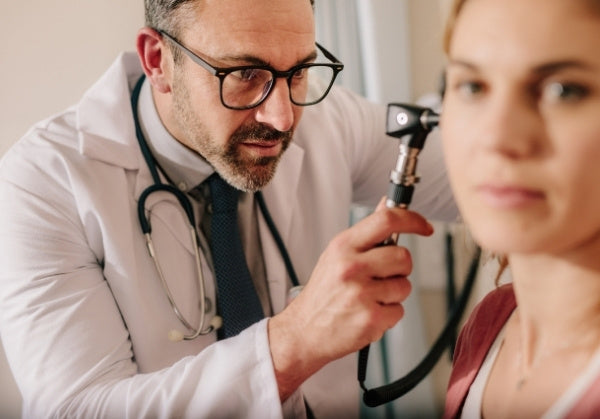
Corneal foreign body removal in general practice using iXope
Share
Dr Louise Stretton is a rural GP. One afternoon, Tom, a fourth-generation farmer, makes a rare visit to her clinic because the wind whipped something into his eye yesterday when he was out in the fields.
Dr Stretton reaches for her direct ophthalmoscope. It’s bulky, limited in scope, and requires her to be just centimetres from Tom’s face, which always feels a little too intense. She spots a speck on the cornea – but there’s nothing she can do about it.
She tells Tom he’ll have to head to the hospital. She knows he won’t go until he’s desperate though, as it’s a 5-hour drive and he can’t leave the farm for that long.
Sure enough, Tom leaves it for a couple of days. By then, he’s really struggling and his wife insists on taking him to the hospital. After a long journey and what feels like an even longer wait in the emergency department, Tom is finally seen by a doctor who tells him the speck has rusted in his eye and he’ll need more invasive treatment and costly follow-up visits with a city-based specialist.
The daily dilemma for GPs
Tom’s story illustrates the frustrations faced by GPs across the country when it comes to corneal foreign body removal.
The avoidable referral
A patient with a visible foreign body must be sent to the emergency department if there’s no way to remove it in the clinic. That’s inconvenient and time-consuming even for city-based patients. For rural ones, it can be almost impossible.
The no-show scenario
The patient is advised to seek emergency or specialist care, but doesn’t go. You stress that it’s urgent but you also understand the constraints they face and the daily responsibilities they shoulder. By the time they do seek treatment, their condition has worsened.
The missed billing opportunity
A relatively quick procedure that could have been performed in your practice ends up outsourced. You lose billable income – and you’re really not satisfied with the fragmented care your patient receives.
The lack of a viable alternative
Dr Stretton isn’t satisfied with the care she was able to give Tom, yet can’t see a way to do more for him. The last time she tried to remove a foreign body from someone’s eye was during her hospital rotation as a junior doctor. She was crouched uncomfortably over a slit lamp, squinting through the binoculars, struggling for the necessary hand-eye coordination when she couldn’t easily see the cornea. The patient was understandably anxious and twitchy. Dr Stretton remembers holding her breath as she moved the needle closer, hyper-aware of how easy it would be to slip and potentially inflict lasting damage on her patient’s eye.
Enter iXope
iXope changes the game by enabling you to remove corneal foreign bodies in your practice using a high-quality, affordable handheld device with slit-lamp capability and excellent field visualisation.
Let’s revisit Dr Stretton. Frustrated by Tom’s experience – and knowing another patient will be in the same position soon – she purchases iXope. Sure enough, a few days later, another patient comes in with a corneal foreign body.
This time, Dr Stretton removes it herself using iXope. To do this, she:
- Positions the device over the patient’s eye – no adapter needed
- Visualises the foreign body in sharp, magnified detail, thanks to 20× optical zoom and LED illumination
- Uses a fine needle, guided in real time alongside the device’s open frame, to gently extract the foreign body
-
Scans the cornea again to confirm full removal and saves the image to the patient’s file.
It’s so different from her experience as a junior doctor. With iXope, she feels capable and confident. Instead of leaning in awkwardly, she’s able to remain at a comfortable distance, watching a crisp, magnified image of the cornea on-screen. She can see both her hand and the patient’s eye at the same time, and the intuitive control makes the procedure feel natural. The patient stays calmer too, since there’s no intrusive equipment in their face, and she can monitor their expressions in real time.
It feels more caring than clinical. It treats the presenting issue immediately, avoiding the risks of delayed treatment. And it keeps the patient in-house, generating revenue for the practice.
🕒 Total time: under 10 minutes
📷 Documentation: done
🧾 MBS Item 42644: billed
😊 Patient: relieved, back on the tractor, singing the GP's praises!
Beyond patient care: revenue & workflow benefits
With iXope, GPs can retain in-practice procedures that were once outsourced:
- MBS 42644 – Superficial corneal foreign body removal
-
MBS 41647 – Micro inspection and toilet of the ear
Each is billable and typically performed in under 10 minutes. If you see just one eye foreign body per week, that’s:
- $80–$120 per service
- Over $4,000 per year in retained revenue.
Factor iXope functions, and the device pays for itself rapidly, helping to boost your practice revenue.
Think beyond your current scope
iXope gives GPs clinical freedom and financial sustainability. No more frustration when you have to send patients elsewhere for procedures you could perform right there and then if only you had the right tools.
With iXope, you see it and treat it, right there in your consultation room.
Disclaimer
This information is intended for healthcare professionals.
